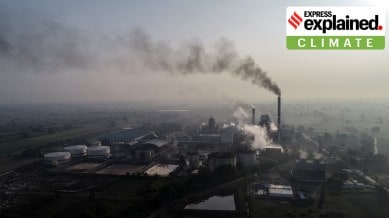What led to the unprecedented increase in CO2 concentrations in 2023-2024
CO2 concentrations increased by a record amount between 2023 and 2024. Man-made activities like burning of fossil fuels, and natural variabilities in CO2 loop lead to this unprecedented rise

The atmospheric concentration of carbon dioxide (CO2), the primary driver of climate change, increased by a record amount between 2023 and 2024, according to the latest data released by the World Meteorological Organization (WMO). Globally averaged CO2 concentration near the Earth’s surface reached 423.9 parts per million in 2024, 3.5 ppm higher than in 2023. The year-on-year increase in this period was significantly higher than the annual average during the 2011-2020 decade.
The year 2024 was also the warmest year ever recorded, with the global average temperature being 1.55 degrees Celsius higher than pre-industrial times. This was the first time that global annual temperatures had crossed the 1.5 degree Celsius threshold, a key limit which, when breached over a long-term period, can result in devastating irreversible impacts.
The rapidly rising CO2 concentrations underscore the failure of the international climate framework, as represented by the Paris Agreement, to achieve a meaningful slowdown in global emissions.
Rise in CO2 concentrations
CO2 concentrations have been rising consistently over the years. There has been no instance of a decline in the last 40 years, at least. However, the new data from the WMO show that the year-on-year increase between 2023 and 2024 was the highest since these kinds of measurements began in 1957. This has come at a time when a massive effort is being made globally to restrain CO2 emissions.
The rate of increase in CO2 concentrations had already tripled from an average of 0.8 ppm per year during the 1960s to 2.4 ppm per year between 2011 and 2020. But a 3.5 ppm jump in a year is unprecedented. The current CO2 concentration in the atmosphere, 423.9 ppm, is now 152% more than the pre-industrial levels of 278.3 ppm.
CO2 is the most widespread of the greenhouse gases (GHGs), and is produced in a variety of natural and man-made processes. The emissions from natural processes such as respiration, ocean releases, volcano eruptions, wildfires, or decomposition of organic matter are nearly all absorbed back in other natural processes like photosynthesis, ocean and land sinks, thus maintaining a balance. Nearly half of the CO2 emissions from man-made processes, such as the burning of fossil fuels, is also absorbed by these natural sinks. It is the other half that accumulates in the atmosphere, resulting in a warming effect.
Although CO2 accounts for more than 90% of all accumulated GHGs in the atmosphere, its ability to trap heat is significantly less than other GHGs such as methane (CH4) and nitrous oxide (N2O). CH4 is at least 25% more potent than CO2 in its heat-trapping capability, while N2O is about 270 times more potent.
However, CO2 remains in the atmosphere for a far longer time, about hundreds to thousands of years. As a result, it has a cumulative impact on global warming. CO2 is known to have contributed about 66% of the warming that has happened since pre-industrial times, and about 79% in the last decade.
In comparison, CH4 is relatively short-lived and remains in the atmosphere for only about 12 to 14 years. N2O disintegrates after about 100 to 120 years.
Reasons behind the increase
The unusually high increase of 3.5 ppm between 2023 and 2024 could not be solely attributed to continued emissions of CO2 from man-made activities, the WMO report said. Variabilities in the natural CO2 loop also had a role to play.
In particular, oceans and land sinks seem to have absorbed a lesser amount of CO2 in 2024. An exceptionally high number of forest fire incidents in the year resulted in additional emissions.
One of the causes of the reduced capability of natural sinks in oceans and land to absorb CO2 is global warming itself. At higher temperatures, oceans absorb less CO2 due to decreased solubility. Similarly, extreme droughts, which result in forests and vegetation drying up, reduce the absorption capacity of trees and grasslands. These processes feed into each other and worsen the CO2 imbalance, leading to more CO2 being released into the atmosphere.
Other GHGs
The concentration of CH4 and N2O also increased in 2024, but the jump was lower than the annual average witnessed in the last decade. CH4 — the second most widely emitted GHG — concentrations increased by 8 parts per billion to reach a level of 1,942 ppb in the atmosphere, while N2O concentrations increased by 1 ppb to reach 338 ppb.
In the last decade, CH4 concentrations increased by an average of about 10.6 ppb every year, while N2O concentrations increased at the rate of 1.07 ppb a year.
CH4 concentrations account for 16% of the warming caused since pre-industrial times, while N2O concentrations contributed about 6%. The rest come from other gases and processes.
Challenge
The new data from the WMO Greenhouse Gas Bulletin underline the enormity of the challenge being faced in restraining the rapid accumulation of GHGs in the atmosphere. It is not just the man-made activities, over which humans have some control, that are accentuating the problem. Natural processes are also getting destabilised under the influence of global warming, resulting in greater accumulation of these gases.
However, even in areas where they have some control, humans have been finding it extremely difficult to rein in emissions of GHGs. Global emissions are still on the rise. Ten years of the Paris Agreement have been unable to make any appreciable dent in this rising trend. The emission reduction targets for 2030 are almost certain to be missed, while global temperatures already breached the 1.5 degree Celsius mark in 2024.